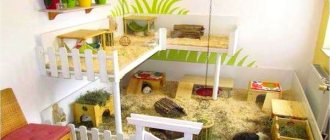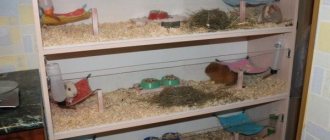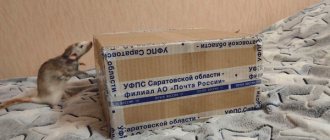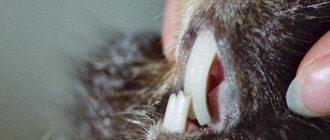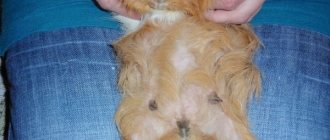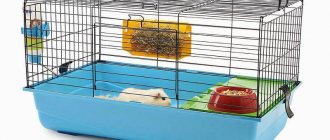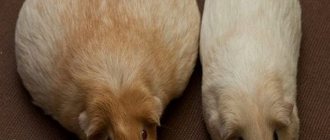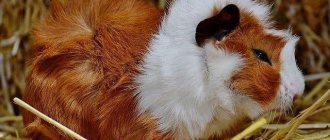Main types of drinkers
Existing drinking bowls for pigs are available in 2 versions:
- ball; ceramic bowl.
For a guinea pig, a ball drinker is convenient because it does not take up space in the cage.
Let's look at their advantages and disadvantages in the table below.
- dryness achieved by the tightness of the structure; small size, allowing installation in a small cage; Possibility of use when transporting in a carrier; suitable from the first days of life; dispenses liquid in doses, eliminating the risk of choking.
- ease of washing; eliminates serious costs, as it is available in any home; does not interfere with the natural position of the body when drinking.
- the animal has to make an unnatural bend in an attempt to reach the ball; the drinking bowl requires regular and labor-intensive washing; when left idle for a long time, the water turns green, and to clean the sippy cup you will have to detach it from the cage each time; the volume emitted by the touched ball does not allow keeping the cage in the bedroom; the drinking bowl is expensive.
- constant dampness in the cage due to splashed water; a rodent may choke without calculating the dose; Large sizes are not suitable for babies (they may drown
When choosing between the presented options, focus on the pet and the conditions of detention. If you have a spacious cage divided into a play area and a dining area, a bowl is suitable, but if the animal is modest in size or young, give preference to a ball sippy cup.
IMPORTANT! In some stores you can purchase metal bowls that come with fasteners. The fixation will help eliminate the risk of spills during active games.
How to train a guinea pig to drink
Guinea pigs are smart animals and quickly figure out how to get water from a drinking device. To do this, it is enough to bring the animal’s nose close, for example, to the drinking bowl ball. The rodent will smell water and begin to try to get it.
If he doesn’t succeed, you can press the ball with your finger in front of his eyes and thus extract a drop of moisture, which you must immediately let the animal lick off. After this, he will figure out how to independently extract water from the drinking bowl.
Did you know? The ancient ancestors of guinea pigs were giants weighing about 700 kilograms.
It is even easier to train a pig to receive water from a device if it is possible to place it in the company of a piggy who has already learned to use this device. The animal will immediately follow the example of its more experienced brother.
How to make a drinking bowl for a guinea pig with your own hands
To avoid defects (low-quality sippy cups can leak) and hazardous materials used by an unscrupulous manufacturer, try making a sippy cup at home.
To create a ball sippy cup you will need:
- ball pen; plastic bottle; bicycle bearing; hacksaw suitable for metal; sandpaper; silicone sealant; thin knife.
You can make a convenient ball drinker with your own hands.
Disassemble the handle into pieces, leaving the body, and remove the ball from the bearing. Place the ball into the housing. It will get stuck in a certain area. Make a mark there and remove part of the handle using a hacksaw, bringing the fixed ball as close as possible to the exit point. Check air flow by blowing into the handle. If present, cut off excess areas. Take the bottle and make a small hole at the bottom to allow a handle to be inserted. Apply sealant to the joint, eliminating the risk of leakage. Tilt the tube 45°. This angle does not prevent water from flowing out when pressing the ball.
Among the advantages it is worth noting: durability and reliability. The only negative is the complexity. If you have no experience, you will have to tinker.
Bottle and cocktail straw
To create a sippy cup you will need:
- cocktail tube (the presence of a corrugated section is required); plastic bottle (from 0.1 to 0.5 l) with a lid; hammer; wire; nail.
Select a nail slightly smaller in diameter than the straw and heat it. Make a small hole in the bottle cap using a hot nail. Insert a straw into the resulting hole. Achieve maximum contact between the straws. Otherwise, all the liquid will leak out. Without removing the straw, screw on the lid and bend the straw 45° upward. Fill the resulting sippy cup with water and draw it through the straw, removing excess air and allowing free access for the liquid. Secure the resulting product with wire.
Among the advantages, it is worth noting the ease of assembly and affordable materials. It is not difficult to find a replacement for a damaged part. However, the tube quickly becomes damaged and the guinea pig can eat the plastic. Despite the existing shortcomings, a do-it-yourself drinking bowl for a guinea pig will allow you to save money and control the safety of the starting materials.
Which drinking bowl is best for a guinea pig?
There is no clear answer to such a question. Existing drinkers, while winning in some respects, inevitably lose in others.
Floor
The ideal option would be a drinking bowl that is as close as possible to the conditions in which these animals are accustomed to drinking water in their natural habitat. In nature, pigs drink water from sources located on the ground. Consequently, any container located on the floor corresponds to the most comfortable position of the animal in relation to drinking.
Familiarize yourself with the peculiarities of feeding and breeding guinea pigs at home.
However, practice makes serious adjustments to these theoretical calculations:
- A really convenient container for animals, located on the floor of their home, very quickly becomes a collection of garbage from throughout the cage, which quickly deteriorates the quality of drinking.
- Water from the floor container inevitably splashes, which creates dampness in the bedding on the floor, which is very dangerous for these animals.
Nevertheless, some owners use floor drinking bowls, using heavy, most often ceramic containers with high sides.
Hanging
The massive body and short neck of the animals make lifting their heads an uncomfortable body position - this is a disadvantage of the hanging drinking structure. The advantages of this type include the ability to easily keep them clean.
You will probably be interested in reading about where the name “guinea pig” came from, how to find out the gender of a guinea pig, how long a guinea pig lives at home, and also find out how much guinea pigs cost.
Hanging drinkers have the undeniable advantage of eliminating the possibility of spilling liquid on the litter and thereby creating dampness. In addition, with timely replacement of water in the container of such a device, the animals’ drink remains fresh, free from foreign impurities in the form of debris and excrement.
How to install a drinker correctly
When installing a drinker, it is important to check the quality of the product. Hang the sippy cup outside the cage, place a piece of paper under the ball and leave it for several hours. Wetness of the sheet will indicate a defect. Consider your pet's physiology. The sippy cup for a guinea pig is placed closer to the floor of the cage to ensure a natural position (the animal should not stretch on its hind legs).
We should not forget about psychological comfort. Place the water bowl outside so that changing water does not interfere with the animal's personal space.
How to attach a drinking bowl to a cage
Since these animals do not really like intrusion into their living space, all water containers, which have to be regularly replenished and cleaned, are usually attached to the outside of the cage using wire or rubber bands.
Important! The drinking bowls should not be placed at such a height that the guinea pig has to lift its muzzle high.
The ends of the drinking bowls, from which the animals directly receive water, be it a plastic drinking straw or a plastic handle body with a ball at the end, are located at a level of 5–7 centimeters from the floor.
What to do if your guinea pig does not drink water from the drinking bowl
Sometimes a rodent will avoid using an intricate device. In this case, you need to act according to the situation.
Diseases
If a guinea pig does not drink water from the drinking bowl and refuses to eat, then there is a high probability of feeling unwell. Be sure to show your pet to the veterinarian.
Lack of experience due to age
If you have enough succulent food, you don’t have to worry about the baby’s health. An adult animal can act as a teacher, since rodents quickly absorb new information and love to imitate.
Disorientation in a new place
If your pet has changed its place of residence and is frantically poking around in search of water, then push it in the right direction and observe. With past experience, he will definitely take the right actions.
Sometimes you have to accustom your guinea pig to a new drinking bowl.
Changing the bowl to a ball sippy cup
You can teach a guinea pig to drink with a ball as an adult using your own example:
- demonstrate the drinking bowl and provide time for independent study (a smart animal often comes to independent conclusions); touch the ball with your finger, causing water to appear; bring a wet finger to the pig; repeat steps if necessary.
IMPORTANT! Stay hydrated. If the pet is weak and does not compensate for moisture with succulent food, then it will have to be given a drink by force, but without a drinking bowl. For such cases, a syringe filled with water is suitable.
Ball drinker: pros and cons
This drinking bowl is not very convenient for a guinea pig, so at first there are difficulties with drinking. The animal needs to raise its head, and the structure of the skeleton, namely a short neck and a massive body, does not allow for deflection and tilting of the head. Also, owners sometimes neglect to regularly wash the bottle, which is why the water turns green and bacteria appear in it. If the cage is located near the sleeping place, the drinking bowl will become a source of noise, because when drinking, the pig pushes it and it rattles against the metal tube.
The advantages are that water does not spill, and the cage is dry. Sometimes it can dig, but this is only a defect of a separate accessory, and not a flaw in the whole. A hanging drinker saves space if the cage is small. It is indispensable when transporting guinea pigs in compact carriers. Before fastening, you need to check whether the locking ball copes with its function. To do this, hang it outside the cage, place a piece of paper and wait a couple of hours.
Keeping a Guinea Pig | Guinea pigs
Keeping a Guinea Pig
Your guinea pig's cage or enclosure should always be kept clean. This is necessary primarily for the health of the pet.
Cage and equipment
At home, it is best to keep a guinea pig in a large, comfortable cage. It should be equipped with a plastic tray that can be removed and put back at any time without disturbing the animal. The cage should be at least 40–50 cm high and 40–60 cm wide. Housing of this size will provide the pig with the opportunity to freely stand on its hind legs and climb onto the house.
A cage intended for several pigs should be larger in size than the one in which one animal lives. Its width and height can not exceed 40 cm, but the length should be at least 90 cm. It is best if the cage for several animals is divided into two sections: night and day. In the first, covered with wooden shields or paper, the pigs will sleep, and in the second, they will feed and walk.
The cages in which guinea pigs are kept are placed 30 cm from the outer walls and 40 cm from the heating system or heating devices.
If the owner of a guinea pig does not have the opportunity to purchase a cage, he can make one himself. When manufacturing a cage, the following conditions must be observed:
• the bottom, walls and ceiling must be without cracks;
• the bottom and walls should be well lit during daylight hours;
• the bottom area must be sufficient for animals to run on the floor;
• the cage should be easy to maintain. Have such a height that the animal cannot crawl out.
Cages for guinea pigs can decorate the interior of a children's room
If desired, you can build a small enclosure for your four-legged pet in the garden or on the balcony of a city apartment. Its bottom is carefully lined with paper, hay or sawdust. Sawdust from coniferous trees, despite their pleasant smell, is not recommended. In the corner of the enclosure you can put a house for the animal.
Pet stores sell a variety of cages for rodents.
They consist of a plastic shallow tray and an open, easily removable wire mesh if necessary. An excessively low trough quickly becomes contaminated with food debris, excrement and bedding elements.
You can place a hollow piece of wood, a brick or a flower pot in a cage with guinea pigs, and you can also make a second floor in the house from knots or wooden stepladders. It should be remembered that the animals’ home should under no circumstances be cluttered, since guinea pigs love wide, free space.
It is also undesirable to use a very high trough, since it will be difficult for a curious pig to look out.
Closed containers made of transparent synthetic material, often used instead of a cage, contribute to the greenhouse effect inside the rodent's home, since they are very poorly ventilated.
It is better to use a homemade wooden box with a height of at least 50 cm as a cage for a pig.
In a guinea pig's cage, you must put 2 feeders (one for hay, the other for green food) and a drinking bowl. Feeders installed in cages should be covered with heavy lids that the animal can climb onto if desired.
Buy feeders of convenient design and good quality.
It is best to use ceramic or plastic ones, which are easy to maintain.
Feeders can be retractable, external, or attached to the floor.
As a container for drinking water, it is best to use a glass or plastic automatic drinker, which can be purchased at a pet store.
The guinea pig will not be bored in such a cage
Equipment required for the cage in which guinea pigs are kept
Regardless of whether the cage is in a room or on a summer cottage, its basic equipment is the same. In addition to feeders and drinking bowls, the guinea pig's home must be equipped with a special house without a bottom with a side hole. In it the animal will rest, sleep and hide from the sun or bad weather.
In the room where guinea pigs are kept, it is necessary to maintain constant temperatures (17–20 °C) and humidity. In addition, the room must be regularly ventilated so that the animals do not suffer from a lack of oxygen. In the warm season, you need to ventilate the room, carefully ensuring that there are no drafts; in the cold season, on the contrary, keep warm. To do this, you can insulate the ceilings, floors and walls, and install double frames.
However, it is worth considering that the microclimate of the cage (especially the closed type) is very seriously affected by the population density of its guinea pigs. If there are a lot of them in the cell, the temperature and humidity rise sharply, and the oxygen saturation of the air decreases.
Guinea pigs feel best in a spacious cage.
In addition, when the cage is overcrowded, the free space necessary for the life of the animals decreases. They cannot rest normally and move actively, which undoubtedly affects their health.
The combination of high relative humidity and low ambient temperature has a negative effect.
The air in the room and inside the cage is saturated with evaporation from drinkers and feeders, evaporation of sweat from the surface of the animals’ bodies and the smell of their glands.
High relative air humidity (about 80–85%) has a very detrimental effect on the body of rodents, changing its heat transfer. The fact is that under optimal temperature conditions, 20–25% of heat transfer occurs due to the evaporation of moisture. The saturated environment does not absorb moisture, and the cooling process of the body worsens.
With a poor balance of temperature and relative humidity, guinea pigs become lethargic, lose their appetite, the metabolism in the animal’s body slows down, and they overheat.
All this together can kill the animals.
Sunlight plays a minor role in the development of guinea pigs. Science has proven that the light of incandescent and gas-light lamps completely replaces natural sunlight, with the exception of the effect of ultraviolet irradiation.
In nature, guinea pigs are more active at night, so immediately after being caught and placed in a cage, these animals do not require intense lighting. On the contrary, in the light, guinea pigs are inactive, eat poorly, tend to hide and do not leave the shelter until dark. Of course, such a lifestyle will not improve the health of the animals.
In order for the adaptation period to take place in a shorter period of time, the cage should be artificially darkened for most of the day. Over time, guinea pigs will get used to the light and begin to be active during the day, then the owner will be able to observe their behavior or show their pets to friends.
But even after the animals have fully adapted, their houses must be darkened so that the guinea pigs can rest in a comfortable environment.
A false bottom is often used in terrariums and aquariums. It is a plastic sheet with many holes, which is installed 2 cm above the bottom of the cage. Its functions coincide with those of the slatted floor. The false bottom allows the pigs to have less contact with their paws with feces and urine, while the need for main bedding almost completely disappears. This bottom allows or actively absorbs moisture, which allows you to save on the purchase of expensive hygiene products.
You can make a false bottom in two ways: take a sheet of thick plastic, in which you drill holes with a diameter of at least 3 mm at a distance of 6 mm from each other.
If the diameter of the holes is smaller, they will constantly become clogged, and if they are larger, there is a risk that the animal’s paws will get stuck in them. Having finished drilling, you need to sand the uneven, jagged edges of the holes with an emery cloth and install a false bottom in the cage on small legs; place a foam polyvinyl chloride mat with many small holes on the floor of the cage.
The resulting soft coating is easy to clean and retains heat for a long time.
Cleaning and disinfection
To prevent various diseases in guinea pigs, cages must be cleaned and disinfected. If the owner does not pay due attention to these two main preventive measures, then the animals will often get sick, and their fur will quickly lose its inherent shine.
It should be remembered that disinfection measures only lead to success when they are preceded by a thorough cleaning of the room in which the animals are kept. The purpose of cleaning is to remove all organic and inorganic debris from the cage where the guinea pigs live.
Experts distinguish 3 layers of mud:
• structural dirt particles;
• mud cover;
• sticky dirt.
During general cleaning, you must remove all equipment from the cage and wash it thoroughly in a soapy solution, and then rinse with clean water and treat with boiling water or a disinfectant.
Cleaning removes the first two layers of dirt and allows the disinfectant to destroy infectious agents.
Before getting guinea pigs, you need to learn how to properly organize the life of pets so that natural hygiene is maintained in the cage, which is an indispensable guarantee of good health and excellent well-being of rodents.
Daily activities for caring for guinea pigs include cleaning the cage and washing equipment. If the bedding in the cage is made of special paper, which is sold in pet stores, then it is enough to change it once every 2-3 days. Experts do not recommend using newsprint as bedding, which contains a lot of printing ink that is harmful to animals.
In the cage where long-haired guinea pigs live, it is recommended to change the bedding daily
It should not be forgotten that if the bedding in a guinea pig cage gets wet, this increases the likelihood of colds in rodents. Therefore, it is best to use highly absorbent bedding and remove wet areas daily.
The shavings are replaced with fresh ones during general cleaning. After each feeding, it is necessary to thoroughly wash the feeders, first removing the remnants of perishable food that the pets have not eaten. Spoiled foods can cause diarrhea or even severe poisoning in guinea pigs.
If guinea pigs are tamed, then it is best to let them out for a walk while cleaning the cage. If they are still just adapting to new conditions of detention, then it is advisable to transplant them into a transport cage or cardboard box.
Greens wither especially quickly and fruits, berries and vegetables spoil. Fresh food and water are given to guinea pigs daily. General cleaning of the cage is enough to do once every 5 days. During this, in addition to such activities as washing the entire cage and equipment, the bedding should be completely replaced. It is best to use for this purpose bedding material in the form of shavings purchased at a pet store, intended for small animals. It is unacceptable to use peat as bedding, since its smallest particles can contribute to the formation of granulomas in the lungs of guinea pigs. Wet peat will stick to animal fur.
During general cleaning, pets can be let out to walk around the room.
Before replacing the bedding, you should thoroughly wash the cage with a cleaning agent or disinfectant (you can also use vinegar essence), and then rinse it well with clean water. When the cage is dry, you can lay out new bedding.
During general cleaning, you need to clean all existing shelves, seats and roofs of sleeping houses from dry lumps of feces with a small brush. If animals stain seat boards or branches with excrement, they should be washed with hot water and soap, disinfected, and then rinsed with clean water and dried.
To disinfect the cage and equipment, you can use bleach or other disinfectants.
Animal hairs stuck to the cage bars can be easily removed with a damp cloth.
Before disinfecting a room for guinea pigs, you need to do a dry and then a wet cleaning. After wet cleaning, all surfaces, as well as equipment, must dry, as water can reduce the concentration of the disinfectant and also cause unwanted chemical reactions.
It is worth noting that you cannot use strong chemicals to treat cells, their equipment, and inventory. Such remedies are used only as a last resort, for example when parasites are detected.
After treatment with a disinfectant solution, the cage must be thoroughly rinsed with clean water.
When going to the dacha or village in the summer, guinea pig owners often take their pets with them. To do this, it is not necessary to bring the animal’s usual cage from the city, since you can quickly build a new one using available materials. It must be at least 50 cm in height, and 100 cm in length and width.
The enclosure for guinea pigs must maintain sanitary and hygienic conditions that meet the needs of the animal. Mice and other rodents should not be allowed to enter the pigs' home.
The country enclosure is a large wooden cage. Its front wall is made of fine-mesh metal mesh, and the floor is made of wooden slats forming a fine lattice. A tray is installed under the enclosure to collect excrement and food waste.
The dacha enclosure should have a grass feeder and a drinking bowl. The first is made from wire, and the second is cut from a plastic bottle so as to form a small transparent funnel, which is attached to the wall of the enclosure with wire. A drinking bowl is inserted into it. A little below its base, in the wall of the cage, a window is made of wire for the spout of the drinking bowl.
There can be 2 feeders in the enclosure: one for grass, and the other for solid bulk or liquid food. It is this feeder that the animal can easily knock over by pouring food into the tray. This can be prevented by drilling 4 holes equidistant from each other in the walls of the container and inserting into them 2 rigid wires 20–25 cm long, bent in the shape of the letter “P”.
In addition to the cage, an aquarium may be suitable for the guinea pig’s home; it will not make noise in it at night. If you cover the top of the aquarium with a breathable mesh, other animals will not be able to reach the furry animal. In addition, the aquarium solves problems with sawdust scattered on the floor. This is probably where the advantages of the aquarium end; it has many more disadvantages:
• the aquarium is more difficult to clean because it is quite heavy and can be accidentally broken;
• the aquarium is poorly ventilated because air enters it only from above, so carbon dioxide and a specific smell accumulate inside. But the problem of poor ventilation can be dealt with if you buy a fairly wide (width should be approximately equal to the length) and not too high aquarium, and cover it with a grill or mesh on top.
• In the aquarium, the guinea pig will have little space to operate. But the owner will be able to observe her behavior, although jumping on her hind legs onto the wall of the aquarium is not as exciting as climbing the bars of the cage. But if the animal can reach or jump to the net stretched over the aquarium, it will begin to perform acrobatic exercises, just like in a cage.
If a cat lives in the house, it is best to choose an aquarium as a home for the guinea pig, which should be covered with glass with holes drilled in it for ventilation. To prevent the cat from moving the lid off the aquarium, you need to put something heavy on it, such as cobblestones or stacks of books.
Most of the time, the guinea pig will travel upside down along the ceiling of the aquarium, trying to chew through the mesh or bars to get out. To prevent this from happening, you should not cover the aquarium with a grille with rods made of soft metals (copper, aluminum). The animal will gnaw through it literally in one evening.
The mesh or lattice must be securely attached to the frame or bottom of the aquarium. The top of the grate can be pressed down with heavy cobblestones placed in the corners. The guinea pig looks very fragile in appearance, but in fact this animal is quite strong.
And one moment. Before you decide where to place your guinea pig - in a cage or an aquarium - you need to think about which sound will irritate family members less: the rattling of a wheel on the metal bars of the cage or on the wall of the aquarium. It will not be possible to place a wheel in the middle of a guinea pig’s home, because the animal will still move it to the wall.
Instead of cobblestones, you can put a stack of books on the mesh of the aquarium, but in this case the animal will try to chew through them in order to get free. If the owner has unnecessary books, he should not fill the lid with them completely, otherwise the animal will simply suffocate.
In some pet stores, special prefabricated houses for rodents have appeared, which consist of several plastic containers connected to each other by pipes made of a similar material. This structure is built like a real underground burrow.
At first glance, it may seem that such a home is ideal for guinea pigs. But it in no way reminds the animals of a mink, since it is made of smooth transparent plastic. They don't really like to crawl on slippery plastic walls. In addition, these houses are very poorly ventilated, even worse than aquariums. They consist of many chambers, the bottom of which cannot be filled with sawdust. As a result, when animals are kept in such houses, a specific smell appears very quickly.
Under no circumstances should guinea pigs be kept in a glass jar or in a round aquarium.
